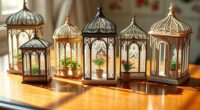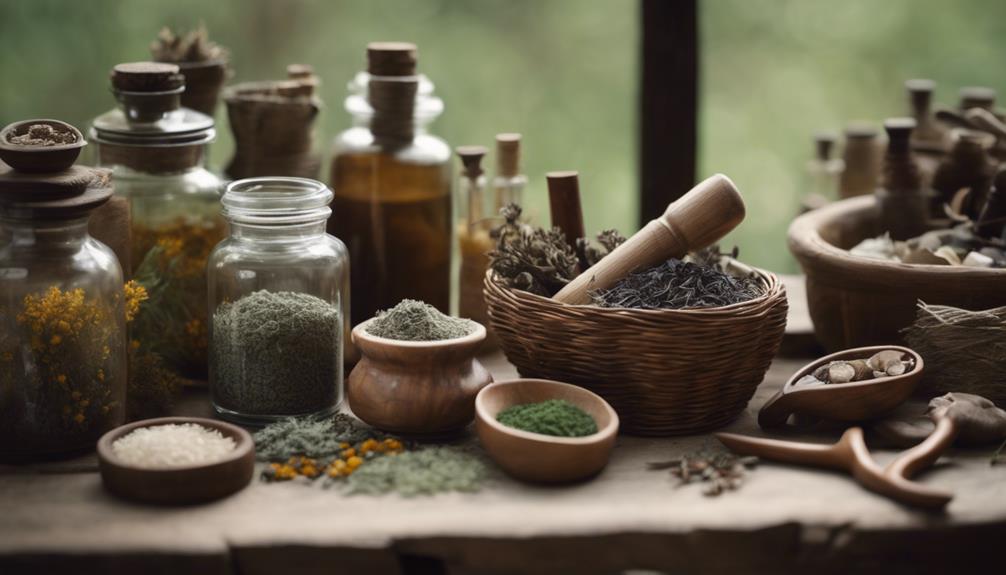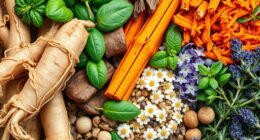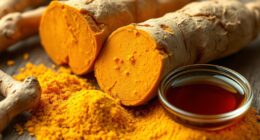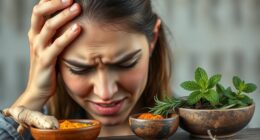To source medicinal herbs safely, choose reputable suppliers with certifications and good reviews, ensuring herbs are organic and sustainably grown. Inspect herbs for freshness by checking aroma, appearance, and texture, and avoid herbs with mold or pests. Store herbs in airtight, opaque containers in a cool, dark, dry place to preserve potency. Proper harvesting, drying, and long-term storage techniques help maintain quality. To learn more about ensuring herb safety and longevity, keep exploring reliable methods and best practices.
Key Takeaways
- Verify suppliers through certifications, reviews, and testing for pesticides to ensure herbs are sourced from reputable, organic, and safe sources.
- Choose organic, sustainably grown herbs and request proof of certification to promote safe, eco-friendly cultivation practices.
- Harvest herbs at optimal times using clean tools, and dry them properly in well-ventilated, shaded areas to preserve potency.
- Store herbs in airtight, opaque containers in a cool, dark place away from heat or sunlight to maintain freshness and efficacy.
- Label storage containers clearly with herb names and harvest dates, and regularly check for signs of moisture, mold, or pests.
Understanding the Importance of Quality in Medicinal Herbs
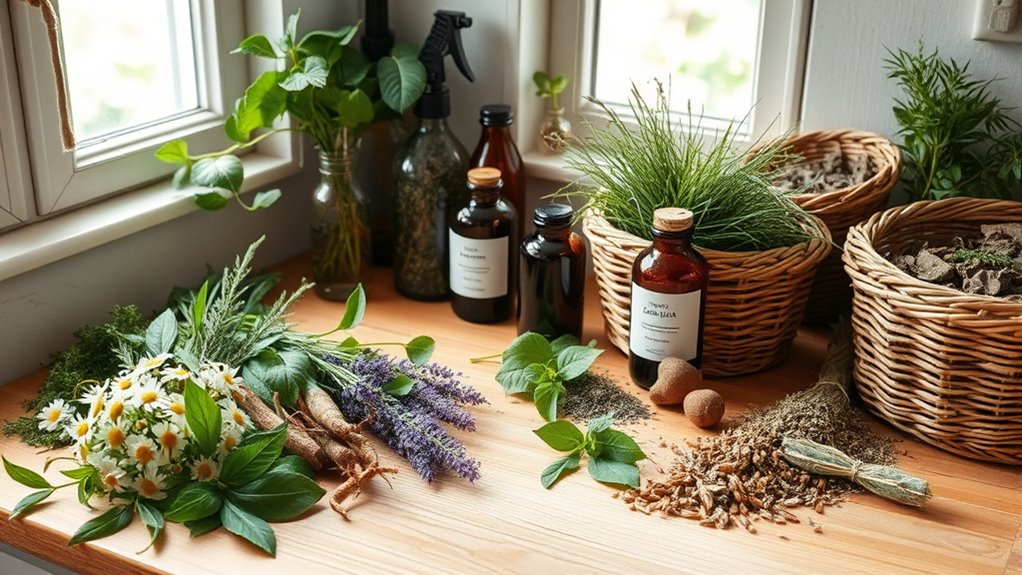
To guarantee you get the full therapeutic benefits, understanding the importance of quality in medicinal herbs is essential. High-quality herbs start with proper herb cultivation and medicinal plant cultivation techniques. When you focus on quality, you’re ensuring that the plants are grown without harmful chemicals and are harvested at their peak potency. Good cultivation practices promote healthy growth, which directly impacts the herb’s medicinal properties. Look for herbs that are vibrant, free of mold or pests, and have a strong aroma. Poorly cultivated herbs may contain contaminants or have diminished active compounds. By prioritizing quality from the start, you maximize the effectiveness of your herbal remedies and support your health goals. Resources and Tools such as access to knowledgeable growers and quality testing can further ensure your herbs meet safety and potency standards. Additionally, understanding herb storage techniques can help preserve the potency and freshness of your herbs over time. Proper herb processing methods also play a crucial role in maintaining medicinal efficacy. Remember, the foundation of effective herbal medicine lies in the herb’s quality and cultivation.
Identifying Reputable Suppliers and Sources
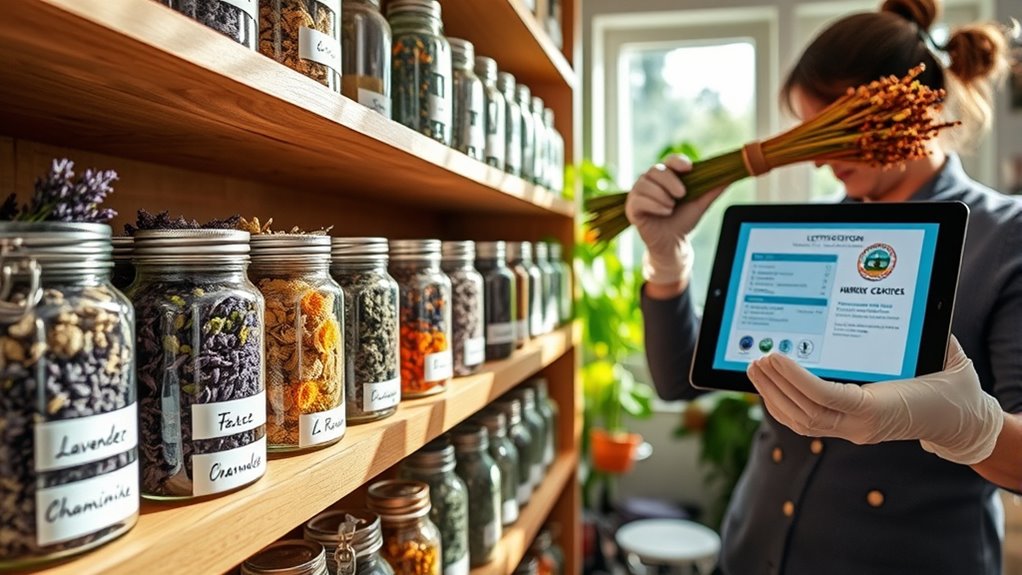
Finding reputable suppliers and sources for medicinal herbs is vital to guarantee you’re getting high-quality, safe products. Start by conducting thorough supplier verification—ask for certifications, references, and proof of quality standards. Reliable sources prioritize transparency and adhere to safety regulations, which helps ensure the herbs you purchase are authentic and free from contaminants. Check reviews and gather feedback from other herbal practitioners or users to assess source reliability. Avoid suppliers with vague descriptions or inconsistent information. Trustworthy suppliers provide detailed information about their harvesting, handling, and storage practices. Additionally, understanding the Nail Styles Names can help you identify and select the best herbs or supplements from reputable sources that might incorporate herbal extracts or herbal-infused products. Properly verifying your sources not only guarantees the authenticity but also aligns with principles of spiritual energy awareness, ensuring your herbal remedies support overall well-being. Implementing quality control measures, such as testing for pesticides and contaminants, further enhances the safety of your herbal products. Conducting regular testing for pesticides and contaminants is essential to maintain high standards and protect consumers. By verifying your sources carefully, you reduce the risk of adulterated or substandard herbs, ensuring your remedies are both safe and effective. Recognizing the importance of ethical hacking principles such as thorough testing and validation can also be applied by herbal practitioners to ensure quality control. Reliable sourcing is a fundamental step toward responsible herbal medicine use.
Choosing Organic and Sustainably Grown Herbs
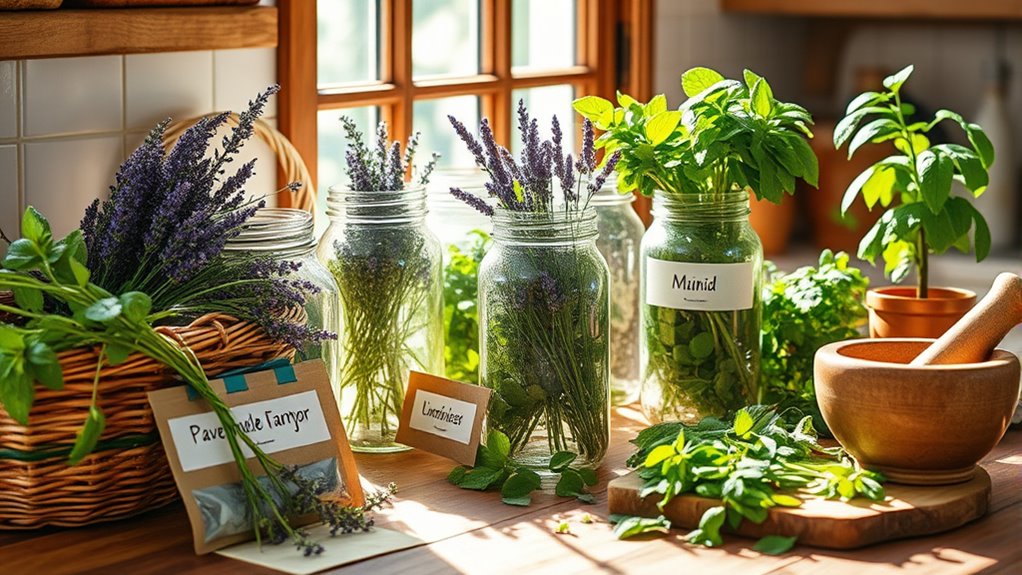
Choosing organic and sustainably grown herbs guarantees you receive high-quality remedies that are free from harmful chemicals and environmentally responsible. When selecting herbs, look for those cultivated through responsible herb cultivation practices that prioritize soil health and biodiversity. Organic certification ensures the herbs meet strict standards, confirming they’re free from synthetic pesticides, fertilizers, and GMOs. By choosing certified organic herbs, you support sustainable farming methods that minimize environmental impact and promote long-term plant health. Always ask suppliers for proof of organic certification and inquire about their herb cultivation methods. This way, you guarantee that the herbs you source are not only potent and pure but also grown in a manner that respects the environment and promotes ecological balance. Additionally, understanding best practices for herb storage can help maintain herb potency and prevent contamination.
Inspecting Herbs for Freshness and Purity
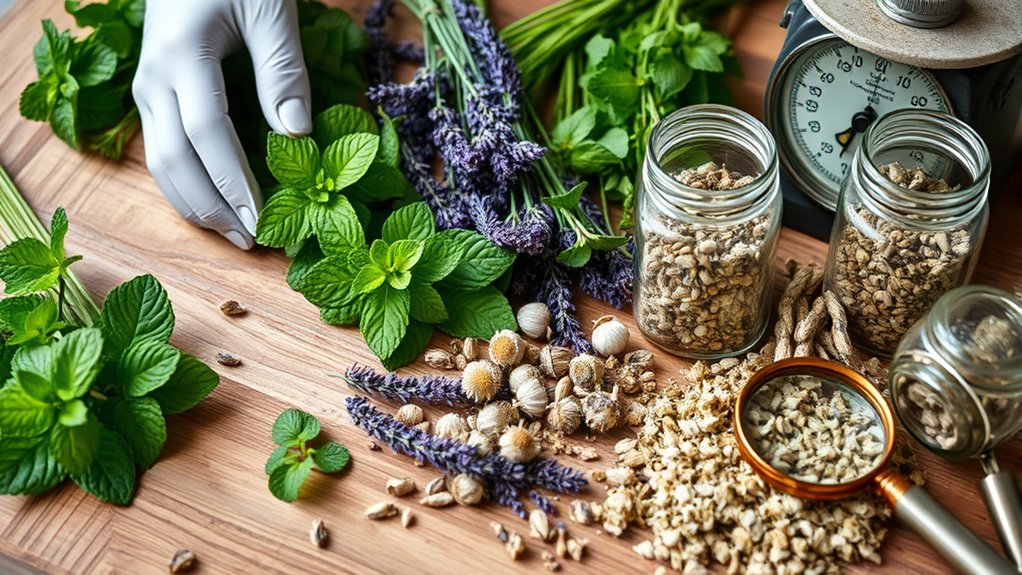
After selecting herbs from trusted sources, it’s important to verify their freshness and purity before use. First, check the herb aroma; fresh herbs should have a strong, pleasant scent, while dull or sour odors indicate spoilage. Second, examine color indicators—vibrant, consistent colors suggest quality, whereas browning or discoloration signals age or contamination. Third, look for signs of mold, pests, or dampness that could compromise purity. Fourth, inspect the texture—herbs should feel firm and dry, not limp or slimy. By paying attention to these details, you ensure your herbs are fresh, pure, and effective for your medicinal needs. Proper inspection helps prevent potential health risks and guarantees maximum potency. Additionally, understanding color accuracy can help assess the true quality of herbs, as color deviations may indicate poor storage or deterioration. Maintaining awareness of herb storage conditions is also crucial to preserve freshness and prevent spoilage over time. Regularly checking these factors can also help identify signs of contamination, ensuring safe use.
Proper Harvesting Techniques for Maximum Potency

To guarantee your herbs retain their maximum medicinal potency, it’s crucial to harvest them at the right time and using proper techniques. The key is understanding the ideal harvest timing for each plant, which varies depending on the part of the plant you’re collecting. For leaves, harvest when they’re fully developed but before flowering begins, ensuring the highest concentration of active compounds. Roots are best dug in late fall or early spring when nutrients are concentrated below ground. Flowers should be harvested at their peak bloom, when their medicinal properties are most potent. Always use clean, sharp tools to minimize damage, and handle plant parts gently to preserve their integrity. Proper timing and technique ensure your herbs deliver maximum health benefits. Additionally, staying informed about the cultural impact of technology on herbal practices can help you adapt your harvesting methods to modern contexts. Being aware of growth stages can further optimize the collection process for different medicinal herbs. Recognizing the influence of traditional spiritual connections can also guide respectful and sustainable harvesting methods. Moreover, understanding advancements in AI technology can aid in identifying optimal harvest times through data analysis, improving the efficacy of your herbal collection. Employing modern tools such as apps and sensors can also assist in monitoring environmental conditions for ideal harvesting.
Safe Drying and Processing Methods

To preserve the medicinal properties of your herbs, you need to dry them correctly and sanitize your equipment beforehand. Proper drying techniques prevent mold and spoilage, ensuring your herbs stay potent. Always sanitize your tools and storage containers to avoid contamination and maintain safety. Additionally, understanding cookie categories can help you manage your online privacy while researching herbal storage methods.
Proper Drying Techniques
Proper drying is essential for preserving the potency and safety of medicinal herbs. To do this effectively, focus on creating the right drying environment—cool, dark, and well-ventilated. Here are key steps to guarantee proper drying:
- Hang herbs in small bundles to promote airflow.
- Keep the drying area away from direct sunlight to prevent degradation.
- Use breathable herb packaging like paper bags or mesh containers to avoid moisture buildup.
- Check herbs daily for dryness; they should feel crisp and break easily.
- Incorporate rustic materials into your drying setup, such as wooden racks or vintage trays, to enhance airflow and preserve the herbs’ natural qualities.
- Utilizing natural sound vibrations can also promote gentle drying and help maintain the herbs’ medicinal properties.
Avoid plastic containers during drying, as they trap moisture. By maintaining a suitable drying environment and choosing the right herb packaging, you assure your herbs retain their medicinal properties safely.
Sanitizing Equipment Properly
Ensuring your equipment is thoroughly sanitized is essential for safe drying and processing of medicinal herbs. You need to regularly disinfect tools like scissors, drying racks, and storage containers to prevent contamination. Use appropriate disinfecting solutions or alcohol wipes to clean surfaces after each use. Sterilizing surfaces before handling herbs helps eliminate bacteria, mold, and spores that could compromise quality or safety. Avoid cross-contamination by keeping tools separate for different herb batches and always cleaning them thoroughly. Proper sanitization not only preserves the medicinal properties of your herbs but also ensures your process remains hygienic. Incorporate routine disinfecting of your equipment into your drying and processing procedures to maintain a safe, contamination-free environment. Additionally, understanding the importance of vetted products can help you select safe and effective sanitizing agents suitable for herbal processing.
Optimal Storage Conditions to Preserve Potency
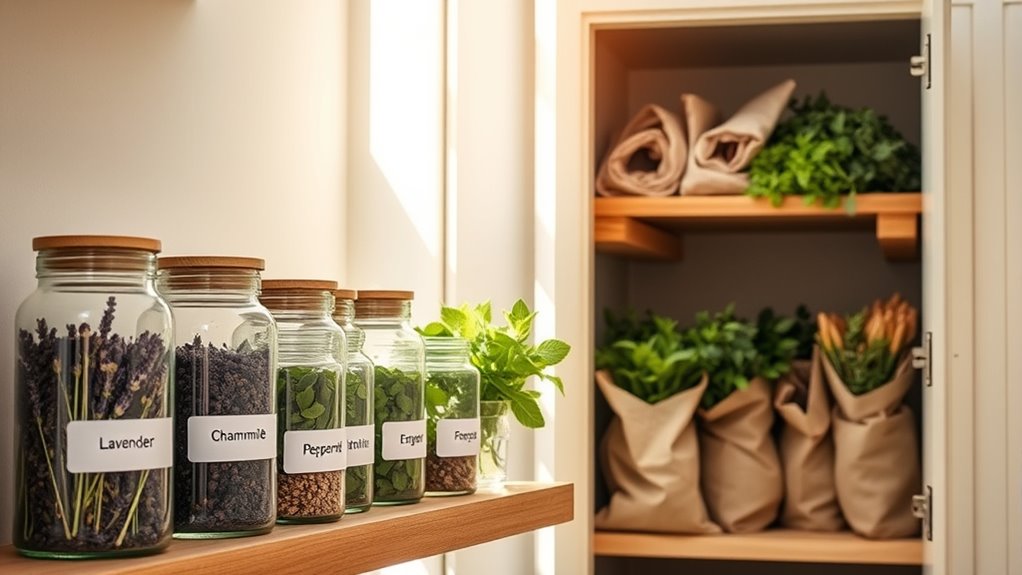
To keep your medicinal herbs potent, store them in a cool, dark place away from light and heat. Use airtight containers to prevent moisture and air from degrading their quality. Maintaining proper humidity levels is also key to preserving their effectiveness over time.
Cool, Dark Environment
Storing medicinal herbs in a cool, dark environment is essential for maintaining their potency over time. Proper temperature control prevents herbs from degrading quickly, while limiting light exposure preserves their active compounds. To optimize storage:
- Keep herbs in a consistent, cool temperature, ideally between 60-70°F (15-21°C).
- Avoid areas exposed to direct sunlight or bright artificial light.
- Use opaque or dark-colored containers to block light.
- Store herbs away from heat sources like stoves or radiators.
Airtight Containers Usage
Using airtight containers is a key step in maintaining the potency of medicinal herbs. They prevent exposure to air, which can degrade essential oils and active compounds. When choosing container materials, opt for glass or food-grade plastic, as these are non-reactive and won’t transfer odors or chemicals to your herbs. Avoid metal containers, which may corrode or react with herbal compounds. Verify your containers have tight-fitting lids to create a proper seal. Properly stored herbs in airtight containers stay fresh longer, preserving their medicinal qualities. Keep the containers in a cool, dark place to further protect the herbs from light and temperature fluctuations. This combination of airtight containers and suitable materials helps extend the shelf life and potency of your medicinal herbs effectively.
Proper Humidity Levels
Maintaining proper humidity levels is essential for preserving the potency of medicinal herbs. Too much moisture can lead to mold, while too little causes herbs to become brittle and lose active compounds. To guarantee ideal storage, focus on humidity control. Here are key tips:
- Keep herbs in a cool, dry place with a humidity level between 45-55%.
- Use silica gel packets or desiccants inside containers to absorb excess moisture.
- Regularly check for signs of mold or dampness, and remove affected herbs immediately.
- Vent storage containers periodically to prevent mold buildup and maintain airflow.
Controlling humidity not only preserves the herbs’ potency but also prevents mold, ensuring your herbs stay effective and safe for use.
Using Appropriate Containers for Storage
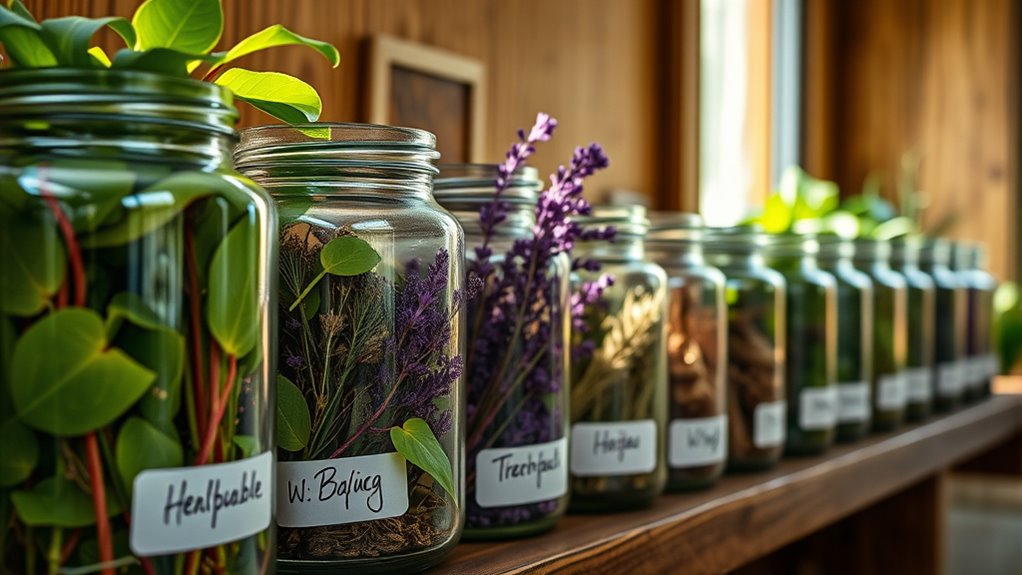
Choosing the right containers is essential to preserve the potency and freshness of your medicinal herbs. Airtight containers prevent moisture, air, and contaminants from degrading your herbs, ensuring they stay potent longer. When selecting container materials, opt for glass or high-quality plastic, as these materials won’t react with the herbs or emit chemicals. Avoid containers made of porous or reactive materials like metal or wood, which can compromise herb quality. Make sure your containers are clean and dry before filling them to prevent mold or spoilage. Properly labeled containers help you keep track of different herbs and their harvest dates. Using appropriate containers not only maintains herb efficacy but also simplifies your storage process, making your herbal remedies more effective and safe.
Tips for Long-term Preservation and Shelf Life

Proper storage containers set the foundation for preserving your herbs, but knowing how to prolong their shelf life is key to maintaining potency over time. To maximize freshness, consider these tips:
Use airtight dark jars, keep herbs cool and dry, and label to preserve freshness and potency.
- Store herbs in airtight, dark glass jars to prevent light and air exposure, which degrade herbal quality.
- Keep dried herbs in cool, dry places, away from heat and humidity, to preserve their aroma and potency.
- For herb infusion and herbal tinctures, use sterile bottles and ensure they’re tightly sealed to prevent spoilage.
- Label everything clearly with dates, so you track freshness and know when to renew your supplies. Proper storage extends shelf life, ensuring your herbal remedies remain potent and effective for months or even years.
Frequently Asked Questions
How Can I Tell if a Medicinal Herb Is Contaminated?
You can tell if a medicinal herb is contaminated by inspecting it carefully for mold, strange odors, or discoloration. Herb contamination often shows up as pests, dust, or an unusual smell. Always prioritize storage safety by keeping herbs in airtight containers, cool, dry places, and away from contaminants. If anything looks or smells off, it’s safest to discard the herb to prevent any health risks.
Are There Specific Labels or Certifications to Look For?
You should look for herbs with clear herb labeling that includes ingredient details, harvest date, and expiry. Certifications like USDA Organic or GMP (Good Manufacturing Practices) indicate the herbs meet strict safety and quality standards. These certification standards guarantee you’re getting uncontaminated, high-quality herbs. Always buy from reputable sources that display these labels, so you can trust the authenticity and safety of your medicinal herbs.
Can I Mix Different Herbs in Storage Without Affecting Quality?
Don’t put all your eggs in one basket—this applies to herb blending in storage. Mixing different herbs can affect their quality if they release oils or scents that mingle undesirably. To keep each herb’s potency, store them in airtight containers, preferably separate ones, and label them clearly. This way, you prevent cross-contamination and preserve their unique medicinal properties, ensuring your herbal remedies stay effective.
How Do Seasonal Changes Impact Herb Potency?
Seasonal variation can considerably impact herb potency, so you might notice herbs are stronger or milder at different times of the year. Warmer months often boost certain active compounds, while colder seasons may reduce potency. To preserve their benefits, harvest herbs at ideal times and store them properly. By understanding seasonal effects, you guarantee your herbs retain their medicinal qualities, giving you more effective remedies year-round.
What Are Common Storage Mistakes to Avoid?
Remember, “A stitch in time saves nine.” You should avoid common storage mistakes like neglecting proper herb drying techniques, which can cause mold or loss of potency. Use proper container selection—airtight, dark glass jars are best—to keep herbs fresh and potent. Don’t store herbs in humid or light-exposed areas, as these conditions degrade quality. Proper storage guarantees your herbs stay effective and safe for use.
Conclusion
By sourcing and storing your medicinal herbs carefully, you’re nurturing a garden of health that blooms with potency and purity. Think of your herbs as delicate melodies—if stored and handled with care, they’ll remain harmonious and vibrant over time. Trust your attention to detail as the conductor’s baton, guiding your herbs’ journey from harvest to healing. With mindful choices, you’ll guarantee your herbal remedies stay strong, pure, and ready to support your well-being whenever you need them.


